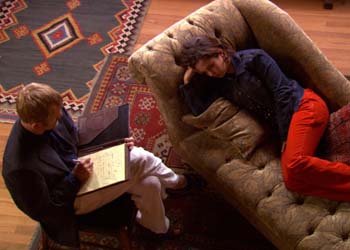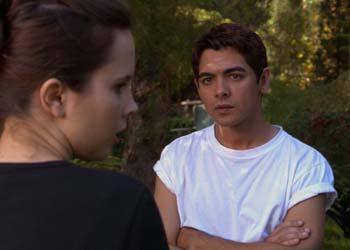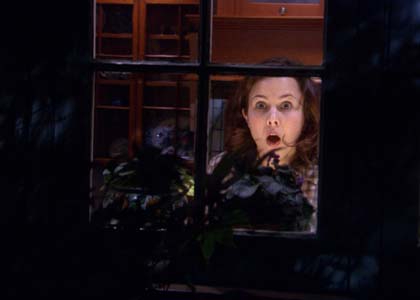|
There is a house located in the Hollywood Hills that is well
documented as a real haunted house. During the decades many
attempts have been made to rid the house of its spirits, but
all of these have ended in failure. What better location to
use as the principle location for Shadowlands latest supernatural
movie Spectres? Darren Rea examines the
origins of one of this year's most impressive independent
movies...
When independent film production company Shadowland was originally
founded, the plan was to be producing 3-5 films a year by
2005. By the end of March, 2003, the young company had a number
of films in development, but none that would afford all the
principals of Shadowland, as well as its key personnel, to
collaborate creatively on a single project. Therefore, the
decision was made that Shadowland's first production should
be developed internally and that it should commence principal
photography by the end of June 2003.
Writer-Producer
Bud Robertson was given the task of coming up with several
story concepts, from which one would be selected for development.
From the Shadowland staff, founder and president Robert Ballo
co-produced the film with Robertson, and also served as director
of photography, Ed Bishop edited the film and served as post-production
supervisor, Brian Dillingham served as line producer, and
Phil Leirness directed.
Of
the half-dozen or so concepts that Robertson pitched, one
was about a teenage girl from a single-parent home, who attempts
to commit suicide. This close call convinces the girl's workaholic
mother that they need to get away together for the summer
- rent a house somewhere and get to know each other. Upon
arriving at their "Shangri-La" in the hills, Kelly is befriended
by ghosts. Are these ghosts real, or is Kelly going crazy?
This question, coupled with an unexpected plot twist and the
rich terrain for thematic exploration that the concept provided,
led the creative team at Shadowland to choose Spectres
as their first feature film production.
By
the start of April, the clock was ticking. The creative team
at Shadowland had less than three months to write the script,
cast the film, raise the financing (half of which would be
provided by Shadowland itself), and complete all aspects of
post-production. Robertson worked closely with director Leirness
in defining the characters so that by the time the first draft
was completed, the two already knew which performers they
wished to approach for most of the key roles in the film.
Although
the story of Spectres follows Kelly on her journey
of discovery, the most important role to cast was that of
the mother, Laura Lee. The one element of the screenplay that
came across quite strongly even in the first draft was that
of the mother-daughter relationship.
Marina
Sirtis (Star Trek: The Next Generation) was the only
actress Leirness ever considered for the role. She had the
science-fiction background, but the real reason Leirness wanted
Sirtis for the role of Laura Lee was his long-standing belief
that there was nothing Sirtis could not do emotionally. Audiences
that see Spectres will be treated to sides of this
popular performer that they have never before seen.
Casting proceeded smoothly, especially considering that what
actors were looking at was a rough first draft screenplay
that needed much work. What the approached performers quickly
realised, however, was that their feedback on the script,
and especially their characters was not only welcome, but
expected. In this regard, performers like Sirtis, Dean Haglund
(X-Files), Tucker Smallwood (Enterprise) and
Alexis Cruz (Stargate: SG-1) became true collaborators
early on in the process.
As
a director, Leirness knew that the most important thing he
could do to ensure a good performance, was to cast the right
actor in the first place and one of the things he enjoys the
most is giving performers a chance to do something they haven't
done before. It was that opportunity as much as anything that
drew Linda Park (Enterprise), Loanne Bishop, Chris
Hardwick and David Hedison (Licence to Kill) to the
project.
The
role of Kelly presented major challenges and Lauren Birkell
not only rose to these challenges as a performer, but the
energy level and enthusiasm she maintained throughout the
process was infectious and helped to support the effort of
the crew on the other side of the camera. Before shooting
began, she was not allowed to rehearse with the other performers
and therefore not allowed to build up a comfort level or rapport
with them. Spectres is a story about a lack of communication,
and about the need we all have to change our perspective at
times in order to be able to communicate. It was decided that
the awkward silences and tension required between these characters
would be more real, more immediate, if Birkell was kept shielded
from the other performers.
 |
On
any film, locations are important, but perhaps the most critical
"character" in Spectres is that of the "house on the
hill" where the bulk of the story's action takes place. After
reading the script and being taken with the story, friends
of Leirness volunteered their home in the Hollywood Hills
for this location. With its' odd angles, three stories and
rooms designed to capture specific emotions, the house enhanced
the story and mood of the film in ways no built sets would
have. In addition, the cast and crew of Spectres were
hardly immune to encounters with the spirits purported to
inhabit the house. Smallwood, for example, heard a seductive,
feminine voice call his name and speak to him quite clearly.
During one take, a streak of light that could not have been
a flare or a reflection is seen flying past Sirtis.
Because
this is, in many respects, a haunting story about isolation,
regret and a lack of communication, it was critically important
that the emotions the characters are feeling be communicated
visually, since they are so often not being addressed verbally.
For this film to work, it needed to be one of long, lyrical
takes, where the audience would feel the silences and the
characters' isolation. The camera needed to always be moving
in such a way as to create unease and a sense that the characters
are always being watched.
 |
In
addition to these visual approaches, director of photography
Robert Ballo and director Leirness worked with chief lighting
designer Mike Stockton and the art department to select colours
that would further enhance the haunting mood of the film,
while also revealing the characters' emotional state. The
choice was made to shoot the film not on 35 millimetre, but
on High Definition, using the Sony 24P. This allowed the filmmakers
to more easily shoot rehearsals, and added an eerie, otherworldly
clarity to the images.
Principal
photography was completed in just twelve days. For this to
happen, on such a complicated film, with such a low budget,
where even these popular performers agreed to work for scale,
everyone needed to bring a passion for the project. Long hours
working in peak summer heat on material that forced every
member of the creative team to confront and explore painful
emotions was made worthwhile by the knowledge that the project
involved would be, at the very least, in Sirtis' words, "A
good story, well acted".

With
thanks to Bud
Robertson at Shadowland
Return
to

|